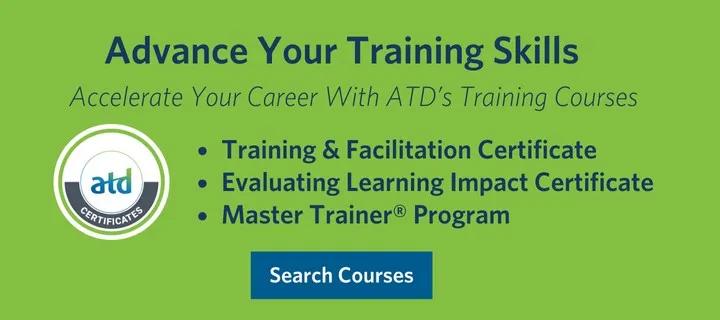ATD Blog
Beyond Virtual vs. In-Person: What New Research Tells Us About Blending Sales Training Modalities
Organizations planning their sales training strategies should focus on creating comprehensive programs that leverage the unique strengths of each modality.
Tue Jan 14 2025

“Should we bring everyone together for training, or just do it virtually?”
It’s a question that sales enablement and training leaders face time and again. With the convenience and accessibility of virtual training tools, it’s easy to assume that online might be the best choice. However, new research indicates a more strategic blend is often most effective.
In fact, 93 percent of organizations with highly effective sales training programs include an in-person, instructor-led component in their training mix. This insight comes from a comprehensive study involving 242 sales professionals across various industries and regions.
The Business Impact
Research shows a clear performance advantage for organizations with highly effective training programs. Compared to those with less effective training, they are:
4.9 times more likely to report getting sellers to full productivity quickly
3.5 times more likely to report having well-prepared sales teams
These highly effective organizations tend to take a blended training approach, combining in-person training (93 percent) with virtual instructor-led sessions (66 percent) and self-study elements (50 percent).
The Value of a Blended Approach
While in-person training positively correlates with training effectiveness, the research indicates that the most effective organizations aren't relying solely on one method. Instead, they combine different approaches to leverage each method’s unique advantages:
In-Person Training: In-person environments offer distinct benefits that can be challenging to replicate virtually. They’re ideal for building excitement and shared purpose, particularly during key initiatives or sales kickoffs. Physical presence allows instructors to read the room, gauge understanding in real time, and make on-the-spot adjustments. Additionally, informational interactions during breaks and group activities cultivate peer learning, collaboration, and networking that reinforce a support system beyond the training session.
Virtual Instructor-Led: 66 percent of highly effective sales training programs include virtual instructor-led training, which offers flexibility while preserving interactive learning opportunities. Ideal for dispersed teams, live virtual sessions can foster interactive discussions and focused skill-building in areas such as prospecting and objection handling.
Self-Study: Half of highly effective sales training programs incorporate virtual self-study components. While sales reps typically forget most training content within a week, retention can be improved when information is reinforced through multiple channels over time. This makes self-study components valuable for knowledge retention and just-in-time learning needs. Organizations with highly effective training are 1.5 times more likely to use digital tools for these learning and reinforcement activities.
Building an Effective Blended Program
Returning to the original question, “Should we bring everyone together for training, or just do it virtually?”
The answer isn’t either/or; it’s both.
As you build your training agenda, consider these strategies:
Design a Comprehensive Learning Program: Develop a program where in-person sessions, virtual training, and self-study resources work together to enhance learning and drive behavior change. Each modality should reinforce the others, creating a more integrated and effective learning experience.
Select Modalities Strategically: Use in-person sessions where they matter most: building excitement and shared purpose at sales kickoffs, gaining buy-in for new initiatives, and strengthening team relationships. Opt for virtual sessions for focused skill practice and feedback. Use self-study for knowledge acquisition and reinforcement.
Provide Ongoing Reinforcement: Don’t stop with the initial training delivery. Organizations with highly effective sales training are nearly five times more likely to provide ongoing reinforcement. Activities such as role-playing scenarios, demos, and practice presentations can drive post-training reinforcement and enable coaching opportunities.
Offer Continuous Learning Journeys: Deliver experiences over time through learning journeys, rather than treating training as a one-time event. Organizations with highly effective sales training are 3.7 times more likely to take this approach. Moreover, they don’t abandon new hires after initial sales onboarding. They are 3.9 times more likely to directly transition new hire onboarding into everboarding.
Integrate Regular Sales Coaching: Make coaching a consistent part of the learning journey. Organizations with highly effective sales training are nearly three times more likely to strongly encourage regular mentoring or coaching. This coaching can happen through a variety of channels—in fact, organizations with highly effective sales training are 1.4 times more likely to provide online coaching than those with less effective training.
Make the Effort to Measure and Assess: Regular assessment of skills and ongoing measurement of business outcomes can help organizations evaluate how their training approach is performing and guide continuous improvement. Highly effective programs are significantly more likely than less effective ones to measure effectiveness by facilitator feedback (2.4 times), employee retention rates (2 times), sales performance metrics (1.7 times), assessments (1.6 times), and employee feedback (1.3 times).
Conclusion
Organizations have more training options than ever, and research suggests the best approach isn’t choosing one modality—it’s blending them strategically. In-person training remains strongly associated with sales training effectiveness, but it may be most powerful when combined with virtual instructor-led sessions and self-study components.
Organizations planning their sales training strategies should focus on creating comprehensive programs that leverage the unique strengths of each modality while providing consistent reinforcement and coaching support.

